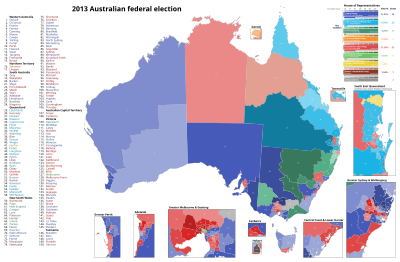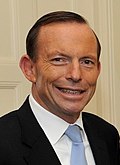
Back Parlamentswahl in Australien 2013 German Αυστραλιανές ομοσπονδιακές εκλογές 2013 Greek Elecciones federales de Australia de 2013 Spanish Australian parlamenttivaalit 2013 Finnish Élections fédérales australiennes de 2013 French Elezioni parlamentari in Australia del 2013 Italian 2013年オーストラリア総選挙 Japanese 2013년 오스트레일리아 의회 선거 Korean Pilihan raya persekutuan Australia 2013 Malay Australische parlementsverkiezingen 2013 Dutch
| |||||||||||||||||||||||||||||||||||||||||||||||||||||||||||||||||||||||||||||||||||||||||||||||||||||||||||||
All 150 seats in the House of Representatives 76 seats were needed for a majority 40 (of the 76) seats in the Senate | |||||||||||||||||||||||||||||||||||||||||||||||||||||||||||||||||||||||||||||||||||||||||||||||||||||||||||||
|---|---|---|---|---|---|---|---|---|---|---|---|---|---|---|---|---|---|---|---|---|---|---|---|---|---|---|---|---|---|---|---|---|---|---|---|---|---|---|---|---|---|---|---|---|---|---|---|---|---|---|---|---|---|---|---|---|---|---|---|---|---|---|---|---|---|---|---|---|---|---|---|---|---|---|---|---|---|---|---|---|---|---|---|---|---|---|---|---|---|---|---|---|---|---|---|---|---|---|---|---|---|---|---|---|---|---|---|---|---|
| Opinion polls | |||||||||||||||||||||||||||||||||||||||||||||||||||||||||||||||||||||||||||||||||||||||||||||||||||||||||||||
| Registered | 14,723,385 | ||||||||||||||||||||||||||||||||||||||||||||||||||||||||||||||||||||||||||||||||||||||||||||||||||||||||||||
| Turnout | 13,726,070 (93.23%) ( | ||||||||||||||||||||||||||||||||||||||||||||||||||||||||||||||||||||||||||||||||||||||||||||||||||||||||||||
| |||||||||||||||||||||||||||||||||||||||||||||||||||||||||||||||||||||||||||||||||||||||||||||||||||||||||||||
 Results by division for the House of Representatives, shaded by winning party's margin of victory. | |||||||||||||||||||||||||||||||||||||||||||||||||||||||||||||||||||||||||||||||||||||||||||||||||||||||||||||
| |||||||||||||||||||||||||||||||||||||||||||||||||||||||||||||||||||||||||||||||||||||||||||||||||||||||||||||
The 2013 Australian federal election to elect the members of the 44th Parliament of Australia took place on Saturday 7 September 2013. The centre-right Liberal/National Coalition opposition led by Opposition leader Tony Abbott of the Liberal Party of Australia and Coalition partner the National Party of Australia, led by Warren Truss, defeated the incumbent centre-left Labor Party government of Prime Minister Kevin Rudd in a landslide. It was also the third time in history that a party won 90 or more seats at an Australian election. Labor had been in government for six years since being elected in the 2007 election. This election marked the end of the Rudd-Gillard-Rudd Labor government and the start of the 9 year long Abbott-Turnbull-Morrison Liberal-National Coalition government. Abbott was sworn in by the Governor-General, Quentin Bryce, as Australia's new prime minister on 18 September 2013, along with the Abbott Ministry. The 44th Parliament of Australia opened on 12 November 2013, with the members of the House of Representatives and territory senators sworn in.[1] The state senators were sworn in by the next Governor-General Peter Cosgrove on 7 July 2014, with their six-year terms commencing on 1 July.[2]
The proclamation dissolving the House of Representatives and formally beginning the election period had been issued by Governor-General Bryce on 5 August 2013. The writs of election were subsequently issued by Bryce for the election of members of the House of Representatives and territory senators, and by the state governors for the senators for each state.[3]
Voting in Australia's federal elections has been compulsory since 1925. For the House of Representatives, a preferential ballot system has been in use since 1919, in single-member seats. For the Senate—the proportionally representative upper house—a single transferable vote system has been in use since 1949, with optional group voting tickets since 1984. Elections are conducted by the Australian Electoral Commission (AEC).
A special half-Senate election was conducted on 5 April 2014 in Western Australia as a result of 1,375 lost ballot papers.[4]
- ^ "Senate - Official Hansard - No. 1, 2013" (PDF). Parliament of Australia. 12 November 2013. p. 1,2. Retrieved 15 April 2022.
- ^ "2013 Federal Election Finally Complete". Australianpolitics.com. 7 July 2014. Retrieved 19 March 2018.
- ^ "Documents relating to the calling of the election for 7 September 2013" (PDF). Governor-General of Australia. Retrieved 15 April 2022.
- ^ "WA Senate election to be held on 5 April". News.com.au. 28 February 2014. Retrieved 19 March 2018.




